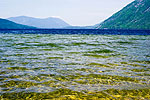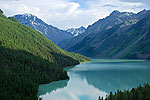“Blagopoluchnyi Baikal!” Lake Baikal is perfect!
The words come from a Russian scientist standing beneath snow-covered Siberian pines next to an unending expanse of slate-blue water, but they could have been spoken by nearly any of Siberia’s 40 million other residents, or Russia’s 140 million.


Hidden deep in the taiga, Baikal is revered within Russia as Siberia’s Sacred Sea, a nearly 400 mile-long cobalt crescent ringed by 7,000 foot mountains and filled with more fresh water than anywhere else on earth. It’s one of our planet’s natural wonders, a place of sublime beauty that through accidents of history and geography hasn’t yet gone the way of so much of the rest of the globe, fundamentally and irreversibly altered by human activity. Throughout the ages, Baikal has remained little known to the outside world, with only a few intrepid foreigners making the always-challenging journey to this frigid inland sea. That’s finally starting to change, and after reading about Baikal, I, too, felt the pull of the lake. As a longtime environmental journalist, I was intrigued by its potential to tell a new kind of story about our relationship with the natural world.
What I found was inspiring — a magnificent work of nature and a growing community of people committed to keeping it in its remarkably pure state, against steep odds.
But is Baikal perfect? Blagopoluchnyi? Alas, I discovered, the idea of the lake’s perfection holds up only if you don’t look too closely. It remains a unique and powerful place, but not powerful enough to deflect all human impact, not unique enough to write its own story independent of humanity. Modern civilization is encroaching, and even Baikal is starting to show signs of stress.
A massive crack in the Siberian plateau, Baikal is its own thesaurus of superlatives. It’s the planet’s deepest and largest lake, plunging more than a mile below the surrounding mountains and holding nearly a fifth of the world’s liquid fresh water, as much as all of North America’s Great Lakes combined. At 25 million years old, it’s the most ancient lake on Earth, and it’s still growing, as the rift that forms its basin broadens. It’s one of the world’s largest repositories of unique species, home to nearly 2,000 animals and plants that live nowhere else, including the world’s only freshwater seal. And perhaps most astonishing of all is Baikal’s legendary water itself, among the cleanest and clearest anywhere. Sail to nearly any corner of the lake and you can see as far down as 40 meters; drop in a bottle and pull out water that’s about as close to pure H20 as can be found in nature. This despite growing pollution from nearby factories and communities.
Baikal’s resilience in the face of human encroachment is among the reasons so many Russians, even some Russian scientists, consider their great lake so powerful, so perfect. It has, they say, a unique, almost supernatural “self-cleansing” ecosystem that can withstand just about anything people can throw at it.
It’s a wonderful notion. But at best it’s only half true.
Baikal does, remarkably, cleanse itself. It’s a complex process, but the cornerstone is the lake’s most plentiful creature — a tiny, endemic, filter-feeding copepod called Epischura baicalensis. Each Epischura is no bigger than a poppyseed, but there are zillions floating through Baikal, which together form an incredibly efficient filtration system. They suck tiny scraps of food out of the lake, and along with them any specks of pollution they encounter. It’s the Epischura that keep Baikal’s water so pure. They are, as one local environmental activist put it, “the heroes of the lake.”
Genghis Khan, who ruled over the Baikal region in the 13th century, is said to have declared Baikal the “great forbiddance zone,” where nothing could be built. That ancient preservationist wisdom largely prevailed for nearly eight centuries. In 1916 Tsar Nicholas II created the first nature preserve in the Russian empire on the eastern shore of Baikal.
But in the early 1960s, the Soviet Union unveiled plans for a huge new pulp and paper mill on Baikal’s southern shore — the first factory to be built directly on the lake. The scheme drew unprecedented protests from Soviet scientists and intellectuals, but to no avail. The Soviets had invented a new super-tough cellulose fiber for military aircraft tires, and said they needed Baikal’s super-pure water to make it. In defense of the motherland, Premier Nikita Khrushchev reportedly declared, “Baikal, too, must work.”
Yet like so many others in the Soviet Union, Baikal’s sacrifice for the good of the people was for naught. By the time the mill opened at the new town of Baikalsk in 1966, its super-cellulose fiber was already obsolete. On the shores of this most extraordinary body of water, the new plant would produce only the most ordinary of commodities — low-grade paper pulp, toilet paper, and newsprint.
Meanwhile, its unofficial product line over the past 40-plus years has included millions of tons of toxic waste — pumped into the air above the lake, into earthquake-vulnerable pools on shore, and into the water. Government reports document pollution releases in recent years at up to nearly fifty thousand times legal limits, and the emissions have been linked to widespread environmental and public health problems.
The construction of the Baikalsk mill was soon followed by a huge new industrial complex on the Angara River, Baikal’s only outlet. These factories, some less than 50 miles from Baikal, are among the filthiest in all of Russia, and prevailing winds carry their toxic clouds down the Angara valley and out over the lake. Elsewhere, growing amounts of sewage and agricultural and industrial waste have run into the lake and its tributaries, along with pollution from construction, logging, and mining.
Away from a few local near-shore hotspots, the extraordinary powers of the heroic Epischura have kept Baikal’s water free of virtually any sign of these insults. But while they make contaminants invisible to most observers, the Epischura don’t really make the pollution disappear. Instead, they merely transfer toxic compounds from the water into the food chain. And with each step along the chain, the pollutants are concentrated thousands of times: At the top, researchers have found Baikal seals with pollution loads rivaling those of seals in the heavily industrialized Baltic Sea. The contamination may be linked to chronic health problems and even to several mass die-offs of seals since the late 1980s. And the humans who live on or near Baikal eat many of the same fish as the seals do, so they may also be ingesting dangerous amounts of pollutants.
Baikal’s “perfection” is being challenged in other ways, as well. As Russia’s economy booms, the number of Baikal-bound tourists — and resorts, hotels, and second homes to accommodate them — is growing fast. And there are plans for many more. In 2007, part of the region was designated a special economic zone for tourism, which authorities hope will attract a billion euros in investment and a million new visitors a year. On paper, Baikal’s entire shoreline is protected. But laws often mean little in today’s Russia, and the lake — until recently almost untouched by tourism — is feeling the impact of this growing human wave. A recent government inspection found 500 illegal new houses on the lake’s shore, causing serious pollution problems nearby. Meanwhile, algal blooms, often linked to human waste, are on the rise, which may in turn be linked to declines in populations of Epischura. These trends could have profound consequences for Baikal’s entire ecosystem. Epischura aren’t only crucial to Baikal’s water quality, they’re also a primary food source for other creatures.
Threats somewhat farther afield include plans for an international uranium enrichment plant — critics call it a nuclear waste dump — just 80 miles upwind of Baikal, and growing talk of a pipeline to carry Baikal water to increasingly parched northern China.
Then there’s perhaps the gravest threat to Baikal’s ecosystem — global warming. In a place defined by cold and ice, winters are getting shorter. A study released in May found that Baikal’s waters have already warmed by 1 degree Celsius (2 degrees Fahrenheit) over the past sixty years, and some scientists predict average regional temperatures will rise at least five degrees Celsius by 2100, with potentially grave consequences for Baikal’s unique ecosystem. Crucial species like the Epischura depend on a narrow range of water temperatures. The Baikal seals’ winter denning habits are already being disrupted. Climate change is already making its effects felt at Baikal.
And yet there are encouraging signs. A number of thin strands are starting to weave together. One, surprisingly, comes from Moscow, which finally seems to be issuing more than flimsy laws and empty pronouncements about protecting Baikal. In 2006, after a sustained public uproar, President Vladimir Putin scuttled a proposal to route an oil pipeline less than a mile from the lake, and ordered it moved out of the watershed altogether. Then in late 2007, after decades of inaction, environmental officials suddenly suspended the license of the Baikalsk paper mill, told its owners to overhaul its waste treatment system, and served notice to sue the company for polluting the lake. The mill is back in business for now, but its days may finally be numbered. At a meeting early this year, Putin’s successor, Dmitry Medvedev, called for a crackdown against polluting companies across Russia.
Beyond Moscow, there’s a growing buzz about the world’s greatest lake, from travel bloggers to The Wall Street Journal to an international community of Baikal activists. Google “Baikal” and you’ll get 3.2 million references, almost twice as many as for the Galapagos Islands. There’s a risk, of course, to even more people wanting to visit Baikal. But it’s also true that no place can be protected without a strong constituency of supporters. This is one reason Baikal was named a U.N. World Heritage Site in 1996 — to celebrate its remarkable qualities, but also to build awareness of its challenges, and create leverage to protect it.
Perhaps most encouraging is the increasing activism of Baikal’s own neighbors. No longer content to accept either dictates or neglect from Moscow, many in the region are trying — some quite literally — to built a sustainable path for their beloved lake and themselves in the face of severe economic challenges in their isolated corner of the world. They’re using the few democratic tools available to them to fight new threats like the oil pipeline. They’re trying to create low-impact businesses that can help wean the region away from dirty industries. And growing numbers are rejecting the lure of large-scale tourism in favor of what they call sustainable tourism, based on home-stays, cultural exchange, native guides, and leave-no-trace activities like hiking and kayaking.
One such effort is the scrappy environmental group Baikal Environmental Wave, which since the early days of the new Russian Federation has been organizing to protect both the lake and the livelihoods and communities of local residents, often in the face of threats and intimidation from government officials. The group was instrumental in leading the fight against the pipeline, and for her efforts one of its founders, Marina Rikhvanova, has just been awarded a prestigious Goldman Environmental Prize for 2008.
Another is the grassroots Great Baikal Trail Organization, which, with the help of such diverse groups as the Rotary Club and Greenpeace, is organizing volunteers from across Russia and around the world to build a network of hiking trails connected to local communities. Over the last five years, nearly 2,000 volunteers from more than 20 countries have built or improved more than 500 kilometers of trail.
Sadly, Baikal is no longer perfect. But what it represents still is — a place where nature’s awesome power and creativity remains on display nearly as we found it, and where it still may not be too late to do right by our environment, and ourselves.